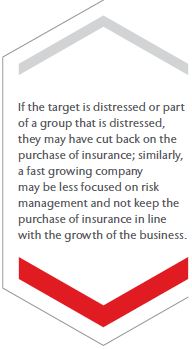
Leveraging Insurance Due Diligence on Cross Border Deals
A common practice in North America, Europe and Australasia, insurance due diligence is a relatively unchartered area in Asia. As a result, understanding of premium costs is limited, leading to underinsurance. Learn how you can navigate insurable risks and understand their related costs.
Insurance due diligence involves reviewing the insurances and related costs for a target company prior to signing a deal. This provides a buyer and the financing banks with an understanding of how well their investment will be protected going forward; equally importantly, it identifies risks and costs (or savings) that should be factored into deal negotiations, either by way of allocation of risks or through price adjustments.
While this diligence stream is relatively common in the developed markets of North America, Europe and Australasia, where insurancerelated costs are much higher, for many Asian companies acquiring targets in these markets, the benefits of this are still not widely understood. We have noted some of these below, focusing on the financial outcomes from undertaking such a process.
While most Asian companies will think of premiums when they think of insurance costs, there may be other costs that should be considered and factored in when reviewing the ‘Total Cost of Insurable Risk’. These include:
- Higher levels of self-insured deductibles on claims: It is not uncommon to see deductibles of USD 100k and above on property and liability insurances, so if there are multiple open claims, there may be multiple deductibles yet to be paid from the P&L of the target. This may be the case for businesses with large workforces, which have been subject to a high volume of work-related injury claims under their Workers Compensation and Employers Liability Insurances.
- Cost of collateral: In the US, there may be collateral requirements from insurers that front the self-insured part of any third-party loss, as well as insuring that part of the risk that is transferred to them.
- Cost of risk improvements required by insurers: Insurers may require or recommend improvements to the safety infrastructure and construction of the premises, the cost of which may be significant, e.g., upgrades to sprinkler systems and replacement of insulated wall panels that represent a catastrophic fire hazard.
These costs can run into six to seven figures. Our specialist risk engineers can advise on whether these requirements are market standard, the practicality of implementing them, as well as possible alternative measures.
Premium costs should also be reviewed. For example, if the transaction involves the carve-out of a division of a much larger business, the target division will not have the same purchasing power as a standalone business. If the acquirer does not have its own global insurance programs to fold the target into (and frequently Asian companies do not), then the cost of insuring the target will most likely spike upwards.
If the target is distressed or part of a group that is distressed, they may have cut back on the purchase of insurance; similarly, a fast growing company may be less focused on risk management and not keep the purchase of insurance in line with the growth of the business. In both instances, the costs may be suppressed by being under or uninsured.
The result of this exercise may be that the ‘Total Cost of Insurance Risk’ is a multiple of the premium cost advised by a seller. For example, the seller may say the premium cost is USD 1m, but once the other issues above have been considered, the ‘Total Cost of Insurance Risk’ may be a multiple of USD 1m, producing a much larger number to be factored into the modeling and deal price negotiations.
Incoming deals to Asia
For western companies investing in Asia, insurance due diligence review can help identify underinsurance and the related cost of rectifying this by purchasing full cover. Given Asian countries are developing markets for risk management, it is not uncommon to find that companies do not have a structured approach to identifying and quantifying insurable risks, or retaining or transferring them to the insurance market.
As a result, there are often gaps in the insurance arrangements of target companies which, if not rectified, could result in significant losses that the target company would have to absorb. Examples of the issues arising include:
- Lack of sufficient cover for cash flow following damage to property. While it may be possible to rebuild a factory or warehouse in Asia within a six-to-twelve-months period, a business may suffer a cash crunch if it cannot deliver products and its customers defect to the competition.
In addition, even when the property is reinstated in six-to-twelve months, it may not be possible to win back customers for a long period of time – for example, 18-24 months.
We often find that businesses underestimate this risk, which may also include interdependency risks between different parts of their business, and the risk of loss due to damage to third-party suppliers and customers. They may have a rudimentary understanding of the risk and little or no awareness of the risk transfer (i.e., insurance) options available to them. Such options provide cover for loss of profits and ongoing fixed costs, as well as additional expenses that may be incurred. - Natural catastrophe risks: These have been highlighted by the earthquake/tsunami in Japan and the Thai floods in 2011. Increasingly companies are looking to identify their exposure to ‘Nat Cat’ risks in these and other countries in Asia, e.g., Taiwan (earthquake, windstorm), Philippines (earthquake, windstorm), and Indonesia (earthquake).
In some instances, the availability of cover may be restricted or there may be co-insurance clauses applicable (e.g., being asked to self-insure 20% of earthquake losses in Taiwan). It would be better to be aware of these prior to signing and of the possible risk transfer solutions that may be available to mitigate such risks. - Lack of co-ordination between contractual risk management and the purchase of insurance: A target’s contracts with customers may include clauses obliging the target to buy insurance to certain limits according to agreed terms. However, the insurance in place may bear no resemblance to the agreed cover. For example, they may be obliged to buy product liability insurance on specified terms and to have the policy cover their customers, but this may not be reflected in the coverage they purchase.
- Declaring property values that only equate to a percentage of the property at risk (e.g., only declaring 60%): There is a lack of awareness that insurers can then reduce a claims payment to the same percentage, only paying 60% of the loss. While this may result in upfront savings on premium costs, the cover in place will not be fit for purpose if there is a claim.
The above are examples of how we help buyers navigate insurable risks and understand their related costs, when involved in an M&A transaction.

If you wish to understand the benefits of this due diligence stream for a specific transaction, please contact us.
Authors
Justin McCarthy
Regional Director
Aon Strategic Advisors & Transaction Solutions
[email protected]
Get in touch
